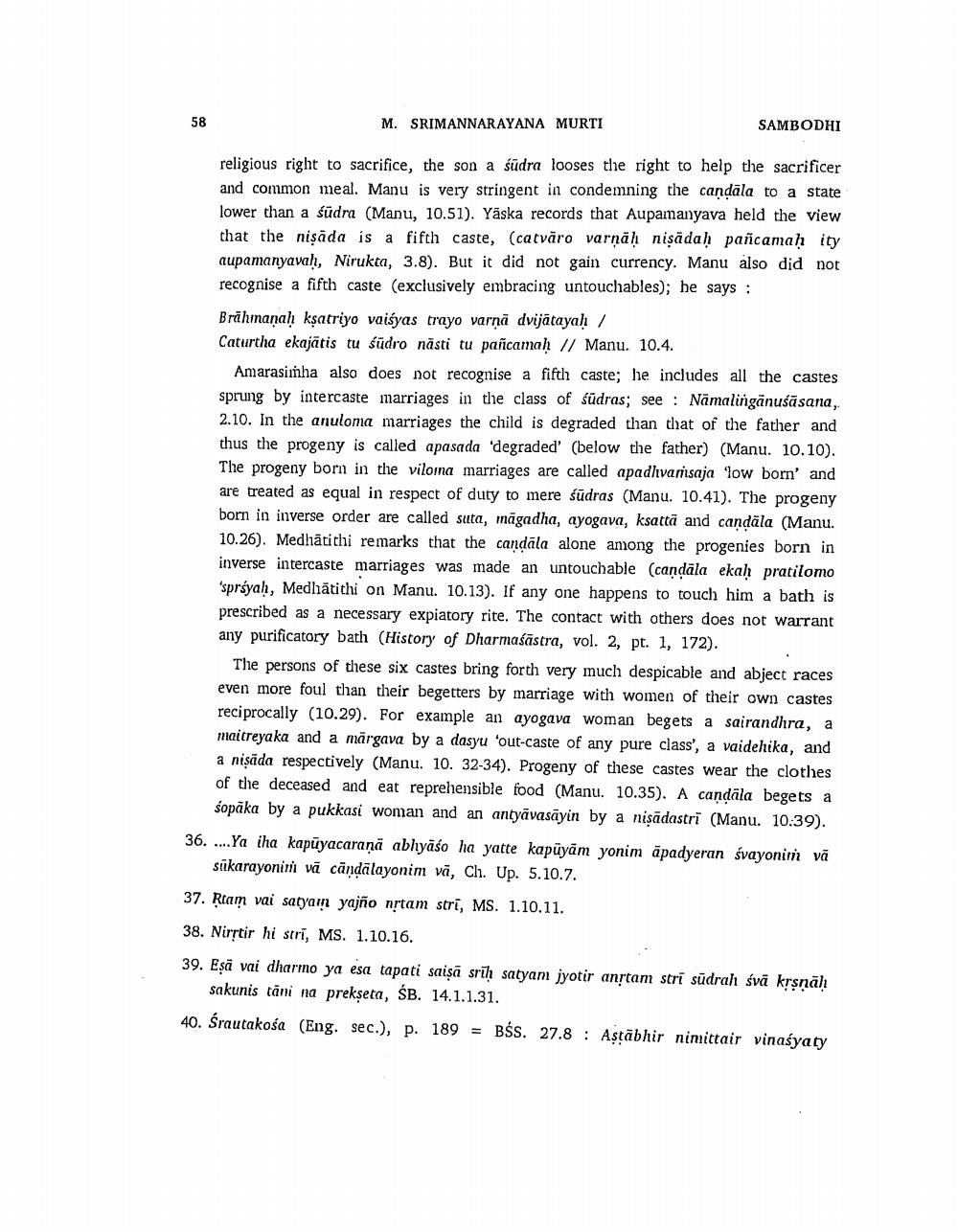________________
58
M. SRIMANNARAYANA MURTI
SAMBODHI
religious right to sacrifice, the son a sudra looses the right to help the sacrificer and common meal. Manu is very stringent in condemning the canḍāla to a state lower than a sudra (Manu, 10.51). Yäska records that Aupamanyava held the view that the niṣada is a fifth caste, (catvāro varṇaḥ niṣādaḥ pañcamaḥ ity aupamanyavaḥ, Nirukta, 3.8). But it did not gain currency. Manu also did not recognise a fifth caste (exclusively embracing untouchables); he says:
Brahmanal ksatriyo vaisyas trayo varna dvijätayah / Caturtha ekajātis tu südro nästi tu pañcamaḥ // Manu. 10.4.
Amarasimha also does not recognise a fifth caste; he includes all the castes sprung by intercaste marriages in the class of sudras; see: Nämalingānusāsana, 2.10. In the anuloma marriages the child is degraded than that of the father and thus the progeny is called apasada 'degraded' (below the father) (Manu. 10.10). The progeny born in the viloma marriages are called apadhvamisaja low born' and are treated as equal in respect of duty to mere sudras (Manu. 10.41). The progeny born in inverse order are called suta, magadha, ayogava, ksatta and candala (Manu. 10.26). Medhätithi remarks that the candala alone among the progenies born in inverse intercaste marriages was made an untouchable (candala ekaḥ pratilomo 'sprsyah, Medhätithi on Manu. 10.13). If any one happens to touch him a bath is prescribed as a necessary expiatory rite. The contact with others does not warrant any purificatory bath (History of Dharmasastra, vol. 2, pt. 1, 172).
The persons of these six castes bring forth very much despicable and abject races even more foul than their begetters by marriage with women of their own castes reciprocally (10.29). For example an ayogava woman begets a sairandhra, a maitreyaka and a margava by a dasyu 'out-caste of any pure class', a vaidehika, and a niṣāda respectively (Manu. 10. 32-34). Progeny of these castes wear the clothes of the deceased and eat reprehensible food (Manu. 10.35). A candāla begets a sopaka by a pukkasi woman and an antyavasayin by a niṣādastri (Manu. 10.39). 36.Ya iha kapuyacarand abhyado ha yatte kapuyäm yonim apadyeran svayonini vä sukarayonim va candalayonim va, Ch. Up. 5.10.7.
37. Rtam vai satyam yajño nṛtam stri, MS. 1.10.11.
38. Nirṛtir hi stri, MS. 1.10.16.
39. Eṣā vai dharmo ya esa tapati saiṣā sriḥ satyam jyotir anṛtam strī sūdrah śvā kṛṣṇāh sakunis tāni na prekṣeta, ŚB. 14.1.1.31.
40. Śrautakosa (Eng. sec.), p. 189 = BSS. 27.8 Aṣṭābhir nimittair vinasyaty




